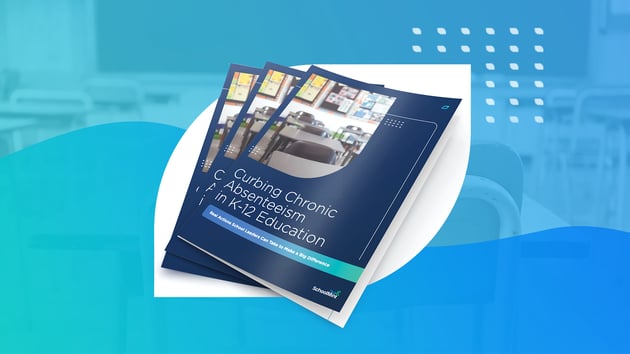7 Tips to Reduce Chronic Absenteeism and Improve Student Attendance
How can you reduce student chronic absenteeism and improve attendance in the new school year?
Chronic absenteeism rates have soared, reaching as high as 40% in some districts across the United States.
This number is startling because chronic absenteeism of students is directly linked to low academic performance and whether a student will drop out of school, among many other negative outcomes.
Since a student needs to miss only 10% of the school year — or two days each month — to be considered chronically absent, any child can become chronically absent.
According to the 2022 School Pulse Panel by the Institute of Education Sciences, public schools have reported an increase in student chronic absenteeism and teacher absences when compared to prior school years.
What can you do to address these rising rates of student absenteeism?
Establish a proactive approach to improving attendance in your school. By doing so, you’ll positively affect the social-emotional and academic good of all students in your classrooms.
Read on to get answers to these questions:
- How does chronic absenteeism affect students — and why do they miss school to begin with?
- How do you reduce chronic absenteeism?
- What is the link between student tardiness, absenteeism, and student dropout?
- What tools exist to help schools manage and improve attendance?
How Chronic Absenteeism Affects Students and Schools
The link between chronic absenteeism and poor academic performance is clear. Students who are chronically absent are more likely to earn failing grades and significantly less likely to read at grade level.
Teachers can’t help a child learn who is not in the classroom. A student can’t succeed when they don’t show up regularly. And families can’t intervene if they’re unaware of the problem — or don’t fully understand the importance of school attendance.
To combat this, create an attendance strategy that outlines how you will reduce chronic absenteeism.
Why Do Students Miss School?
Here are a few of the most common reasons students miss school:
- Deeper problems at home. It’s an unfortunate truth that some students come from homes where their family is facing hardship and are unable to attend school despite their wishes to learn.
- Lack of safety. A child may face unsafe conditions going to school or coming home, leading to them being tardy or absent.
- Transportation. Not all students have reliable transportation to and/or from school.
- Illness or disability. Students who are disabled or have a chronic illness are one of the groups hardest hit by chronic absenteeism. They may not have access to medical care or medical excuses.
- No sense of belonging. When a student doesn’t feel connected to their peers, a teacher, or the school, there’s little incentive for them to return.
- Academic and/or social embarrassment. Students who experience chronic absenteeism miss assignments, tests, and lessons, all of which lead to failing grades.
The above list isn’t comprehensive. There are other reasons, such as children who go on vacation during the year or families who forget to submit paperwork for excused absences.
How to Reduce Chronic Absenteeism of Students: Tips and Strategies That Make a Difference
Chronic absenteeism is a deeply complex issue, but for educators looking to make a difference, there are places they can start.
When chronically absent students do come back to school, they rarely escape the absenteeism cycle — unless the school has taken steps to support their success.
When they do show up, there’s a pile of catch-up work waiting for them. Once behind, it’s difficult for students to make up that work, so they get poor grades and lose out on credits. You can see how this cycle only reinforces itself.
Read below for seven tips to stop this cycle in its tracks, get students back in class, and see your rates of tardiness and chronic absenteeism begin to trend downward.
1. Cultivate Strong Relationships Between Students and Teachers
Teachers can work to make each student feel included by building personal connections. Students need someone they can trust for school to become a place they want to be.
Cultivating strong relationships between students and staff — or even implementing a mentorship program for students — can make individual students feel connected to their community and as if there’s someone fighting for them even when it feels like the world is against them.
These positive interactions between the student and an adult at school are key to curbing absenteeism. This is even more important for children from marginalized backgrounds or children with special needs, who often face additional roadblocks to success.
A positive behavior reinforcement tool like SchoolMint Hero can increase positive interactions — the foundational building blocks to healthy relationships between students and teachers.
2. Provide Supports for Chronically Absent Students When They Return to Class
When a student returns to school, don’t let them drown in missed work. Returning to school only to feel overwhelmed by what they return to can make their absenteeism worse.
Additionally, the child may feel embarrassed by being academically behind if they don’t understand the work and may feel that they’ll never get up to speed.
Instead of telling the student to complete every missed assignment and test, collaborate with that student’s teachers and family to put a plan in place for how that child can return to class and catch up to their peers.
3. Reduce Student Tardiness to Reduce Chronic Absenteeism
Reducing chronic absenteeism of students starts with understanding that absenteeism doesn’t appear overnight. It’s often a progressive problem.
First a student is tardy. Then they’re chronically tardy. Over time, that turns into absenteeism. And far too often, chronically absent students drop out, which drastically affects their path through adulthood.
Reducing student tardiness should thus be a significant part of your strategy to reduce student absenteeism.
Stop the cycle by prioritizing getting students to class and then reinforcing their positive attendance behavior when they return.

4. Use Tardy and Absentee Data to Find At-Risk Students
Even when transportation and home life aren’t issues for a child, some students choose not to go to school. There are many reasons why a child chooses to do this. But the burden is on the administration to find out why.
Gathering and analyzing tardiness and absenteeism data can help you discover that “why.”
A platform that can compile this data for you can make this process easy. Manually tracking student behavior and attendance is time consuming and makes it hard to identify behavior trends.
By investing in a behavior management platform that offers behavior analytics, you’ll be able to pinpoint where in the day students struggle with attendance, helping you form a plan to address the problem, intervene, and get them back to learning.
You can learn more about the stories behavior data tells in this previous article, What Student Behavior Patterns Can Tell Us.
5. Use Positive Reinforcement to Improve Student Attendance
When you reward or positively acknowledge a student for displaying the behaviors you want, you encourage that child to repeat that behavior. Because of this, a positive behavior program can be highly effective at improving attendance.
But there’s a caveat here: the positive reinforcement must occur in the context of a positive program. Students must be engaged and care about the rewards for exhibiting good behavior. And using positive reinforcement to improve attendance can be surprisingly simple.
For example, in periods where you have an attendance problem (which, if your school is like most, this will be first period), ask teachers to reward students who show up on time and ready to learn.

However, for your positive reinforcement plan to be effective for curbing tardiness and absenteeism, note that you should give the reinforcement immediately after the behavior you’re trying to increase. In this case, the behavior is showing up on time.
For the reward to resonate best with the student, it must be given as quickly as possible to the behavior’s occurrence. Additionally, all positive reinforcement should be genuine and age-appropriate.
You can get some student incentives and other ideas in Student Engagement: Tips, Tricks, and Incentives.
6. Get Families Involved with Their Child’s Attendance
Early intervention is key to curbing chronic tardiness before it escalates into chronic absenteeism.
There can be many reasons a student is tardy. You’ve probably heard them all and know that some are legitimate. And that many are not.
No matter the excuse, though, you should get parents and guardians involved early in the process. Without involving a student’s family, parents and guardians may never know their child has an attendance problem at school.
For example, a student who is chronically absent from their first class of the day may be avoiding that subject or that teacher. Speaking to their parents can help uncover what’s going on.

As another example, if there’s a student who avoids school due to being unable to wash their uniforms at home and no access to/money for a laundromat, there may be someone in your school who can discreetly help this child out.
Here are some other tips for getting families involved:
- Send push notifications, a robo-call, or an automatic email when that student is tardy or absent. This may be all a busy parent needs to become aware of the problem.
- For families who come from a lower socioeconomic background, provide them with community resources. Directly intervene if it’s within your capabilities, and help resolve the barriers they face to regular school attendance.
- Host a parent–teacher alliance meeting that focuses on the importance of regular attendance, why chronic absenteeism hurts students, and how you can all work together to make attendance a priority.
7. Be Consistent and Fair
It’s unlikely you will ever completely eliminate tardiness and student chronic absenteeism in your school. But fortunately, attendance improvement programs tend to pay off quickly.
For example, our SchoolMint Hero partners often see tardiness reduce 30–80% within the first few months implementing Hero.
To maintain success with improving student attendance, it’s important to keep two things in mind:
First, you must keep doing it.
Consistency is one of the most important pieces toward improving student behavior.
Day to day and week to week, you must be consistent with the expectations you’re setting for students. Inconsistency can cause tardiness — and subsequently absenteeism — to creep up again.
Reducing absenteeism and improving student attendance is an ongoing, proactive process — not a one-and-done thing.
Second, you must be consistent across classrooms.
You must also consistently apply your attendance standards across classrooms. This will ensure fairness in your discipline and minimize the severity of tardiness spikes during times when attendance drops, such as when students’ schedules change.
Reduce Absenteeism and Tardiness: SchoolMint Hero
SchoolMint Hero allows school administrators to scan a student’s ID or search by name, then print a tardy slip. Start to finish, it’s a 10-second process.
You can get back to your job that much sooner. And that student can get back to class just as quickly — and get back to learning rather than missing out on critical instruction time.
Get in touch to learn how SchoolMint Hero can improve student attendance in your school.
Share this
You May Also Like
These Related Stories

How to Reduce Referrals with Positive Behavior Reinforcement

Aspira Early College High School: Decreasing Student Tardiness by 86%



